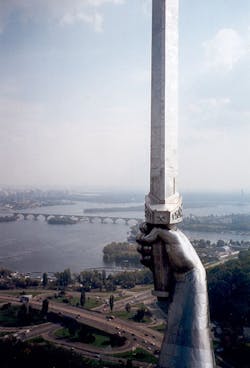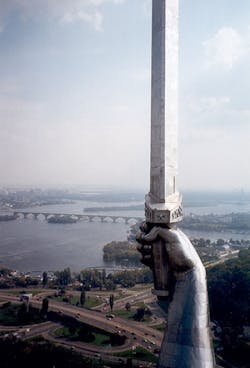Ukrainian Upgrades
Tariff reform and metering services are urgently required in the former Soviet technical centre. Stephen Hubbs discusses how a recent dramatic increase in water rate to the Rubisne area suggests the country is well poised for continued growth.
Ukraine is a resource-rich state with a highly educated workforce and sophisticated cultural history. It rose as a Soviet industrial/technical centre from 1950 through to 1990, and has been in transition from a communist system of governance to a democratic system for the past 20 years. It occupies a pivotal position both geographically and politically between Western Europe and Russia, which provides unique opportunities and challenges for business development.
Soviet Union growth
The water supply challenges for Ukraine are significant. Many surface and ground waters supplies are impacted by municipal and industrial discharges, treatment facilities require upgrading and the distribution systems suffer from significant water losses due to leaks and breaks. Of these challenges, the problems in the distribution systems appear to be the greatest, as unaddressed leaks and breaks result in water losses estimated in excess of 50%. These losses result in greater power costs and reduce reliability of the overall water supply system.
And it's not just Ukraine plagued by such issues. The condition of the distribution piping appears to be common to many post soviet states. So how did this come about? During the 1980s the Soviet Union was experiencing tremendous growth, which resulted in a shortage of fittings for cast iron pipe. The response was to install uncoated steel pipe with welded connections, which would typically have a lifespan of about 20 years. For many of the Ukrainian cities experiencing growth during the 1980s, these pipe systems are now seriously deteriorated. Rubishne, located in Eastern Ukraine near the border with Russia, is one of these communities, and will serve as an example of local conditions in Ukraine.
Water losses through leaking distribution systems is one of the problems driving the necessity for a "water schedule" used in many Ukrainian cities. Here, supply pumps are only on for a portion of each day, leaving the system depressurised for the remainder of the day. This cycling of water pressure further stresses an already fragile pipe system, and creates public health risks due to increased potential for cross connection and siphonage when the system is depressurised.
Water supply needs
Most Ukrainian cities have limited resources for replacing or rehabilitating their infrastructure and are focusing repairs on the worst leaks as they appear. Prior to 2004, many water utilities made repairs with steel pipe, as this was the only affordable material available. With the construction of two polyethylene (PE) pipe plants in Ukraine in 2005, PE is now also being used for repair and replacement.
The cost to replace all of Ukraine's infrastructure needs (water, sewer, gas, electric) has been reported at US$2.5 billion. Approximate estimations suggest replacement costs for all steel pipe in Ukraine stand at $250 million to $500 million US. In Rubishne, approximately 15 of the 43 kilometers of pipe in the system are steel pipe which have reached the end of their service life. The cost for replacing 1 kilometer of 500mm pipe is about US$60,000, with approximately 70% of this being material costs. Materials for a 10-year replacement/rehabilitation program for a typical Ukrainian city with a population of 100,000 were estimated by one city to be approximately $200,000 per year (2005 costs). One advantage is that labour costs are relatively low due to the employment market.
Several cities in Ukraine had started the planning process for infrastructure over five years ago. The process typically included building an inventory of pipes by size and age, mapping leaks and breaks by year and location and providing a projection of pipe replacement needs over a 20-year period using as much historical data a possible.
The pre-planning would then be followed by an analysis of leak/break data and initiation of an active leak detection program to allow prioritisation of the program (which pipes get replaced first). The final stage of financing and construction had begun in 2005 in several cities, but funding was limited.
In addition to the pipeline needs, equipment needs for leak detection, water main construction and treatment plant equipment are significant in Ukraine. Groundwater supplies in some areas have been impacted by industrial operations, while other areas were managing scarce groundwater supplies to minimise contamination risks.
Metering and the tariff dilemma
Following the dissolution of the Soviet Union most post-soviet states were faced with the need to provide metering to residential customers to better control water use and payment. As there were typically no valves on the service lines leading into the homes and housing buildings, water service was not shut-off for lack of payment. Rates were set artificially low, resulting in an income inadequate to cover existing operating expenses and the much needed infrastructure renovation. In Rubishne, 35% of residential customers were metered as of 2005, with the balance on a flat-rate tariff structure. The Rubishne water tariff was 0.75 UAH/m3 ($0.14/ m3 or $0.5/1000 gallons), with regional rates ranging from 0.75 to 1.15 UAH/ m3. The tariff structure covered only two-thirds of apparent operation costs. Attempts Initial attempts to implement tariffs that reflected cost of service were approved by council, but were later rejected due to political intervention.
Tariff reform is a politically charged topic in Ukraine, noting the economic situation and a population historically accustomed to not paying for water. Thus, most municipalities are have been hesitant to increase water rates, and have had limited ability to provide any incentive to make delinquent customers pay their water bills.
A law enacted in 2005 required that local municipalities must subsidise any water utility operation costs that were not covered by tariff (implying that they would not be subsidized by the state).
| History: the impact on business prospects Ukraine's history is significant in the last 100 years with regards to political relations with Russia and western Europe. Historically coveted for it's resources and cultural centre in Kiev, Ukraine has been a battleground throughout modern history. Its population in 1900 of about 100 million was cut in half through the first 30 years of the 1900s, and by half again to 25 million by the end of Stalin's reign and World War II. This dramatic population drop occurred as a result of both war, starvation and emigration. Ukraine's population increased following WW2 to 50 million through 1990, but has declined since the breakup of the Soviet Union to about 37 million today, mostly the result of a decreasing birth rate. These dramatic shifts in population and the causes are hard to comprehend for those accustomed to political stability, and the impact on trust and confidence in government in Ukraine is significant. Following independence of the Soviet Union in 1991, Ukraine struggled through typical political fractioning and power struggles. Elections in 2004 were largely regarded as corrupted, and were followed by a massive peaceful demonstration known as the "Orange Revolution". This resulted in an overturning of the election results and the establishment of a more western-leaning government. This movement failed to coalesce into an effective government over the next six years and the previously ousted pro-Russia party resumed control in 2010. Ukraine's politics today remain divided between the more nationalist factions in western Ukraine, and the more Russian sympathetic factions in eastern Ukraine. Contentious issues include the transport of Russian gas through Ukraine into markets in western Europe, and the lease of the Ukrainian port of Sevastopol to the Russian Navy. Against this background of economic hardship, mistrust for government, and tumultuous political challenges, corruption can be expected. For example, the "Global Corruption Report"(1) published by Transparency International in 2009, showed 21% of 1,200 respondents asked reported paying bribes to government officials, and 73% felt the government was ineffective in dealing with the problem. Similar numbers were 63% and 58% for Russia, and 2% and 73% for the US, respectively. This results in a business environment where the true cost of doing business can be difficult to access. The need for transparency in business and government is widely discussed by politicians, the press, and business groups as a critical need in Ukraine. |
Compliance with this law was not universal as of September 2005. A review of one utility balance sheet in 2002 indicated a substantial imbalance between revenue and operating costs. Three years later this imbalance was largely corrected when barter was added to the balance sheet. For utilities with massive water losses in the distribution system, the move towards metering creates a problem with tariffs that are based on flat rate usage. The tariff is based on an assumed water loss in the distribution system of about 15%, but this loss is likely 30% or more.
As metered homes tighten up plumbing and conserve usage, revenue to the utility will likely drop at a greater rate than the cost savings from reduced production costs (despite the fact that water costs more to produce than is covered by revenue).
This loss of net revenue as a result of metering was estimated for a utility to be 15%, considering a reduction in residential consumption of 30% (20% reduced in-home leakage and 10% conservation). Thus, to cover costs of reduced water revenue due to metering, a utility would have to consider tariff increases of 15% just to break even with currently under-funded tariff structures.
The future costs of infrastructure rehabilitation further widened the gap between revenue and the true cost of producing water will drive even higher costs for water supply. Tariff reform was needed to cover both operating costs and reform will be necessary to provide adequate resources for future pipeline rehabilitation projects.
Ukrainian cities are starting to respond to this need for tariff reform. The current water rate in Rubishne has been dramatically increased to 5.8 HRN per cubic meter, which much better reflects the actual cost of providing water to the community. They now operate around-the-clock, and have recently upgraded pumps for more efficient operation. In Kiev, the current water rate was increased from 1.48 HRN to 2.78 HRN per cubic meter from 2009 to 2010, with another increase being considered for 2011. These changes bode well for more stable water utilities in Ukraine.
Despite the current economic challenges, the changes in water tariffs signal that Ukraine is well poised for continued growth in the future.
The availability of abundant natural resources, a highly educated population, and greater transparency through the press bodes well for stability and economic development. The development of trusted business relationships within Ukraine would help define the cost and reduce the risk of doing business in Ukraine.
References
(1) Global corruption Report, ISBN: 978-3-935711-28-9, © 2009 Transparency International.
Author's note:Stephen Hubbs is currently a water consultant and was previously the vice president for water quality and production at Louisville Water Company. The article reflects the observations of Hubbs' visits to Ukraine, with work including utility condition assessment, management training, and utility/regulator communications. The majority of this time was spent in Rubishne in eastern Ukraine and much of the information insight for this article comes from this municipality.
More Water & WasteWater International Current Issue Articles
More Water & WasteWater International Archives Issue Articles


